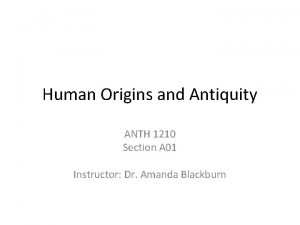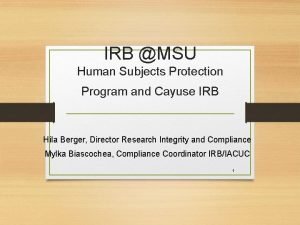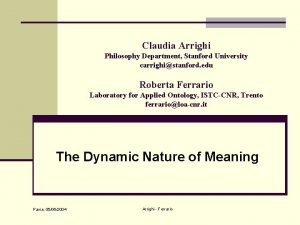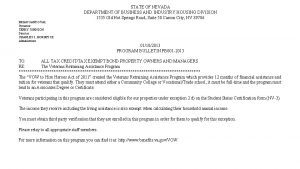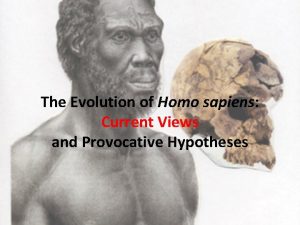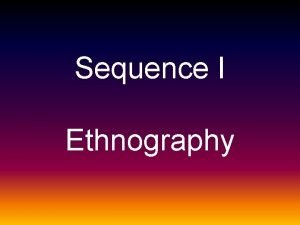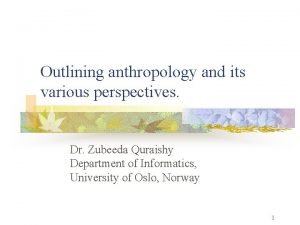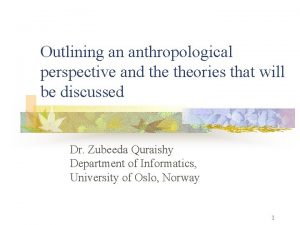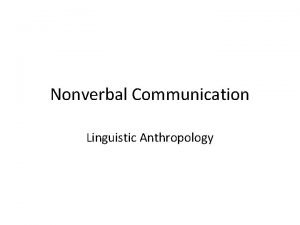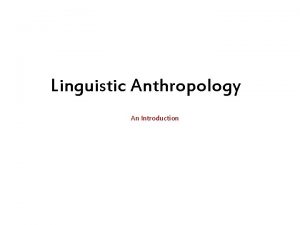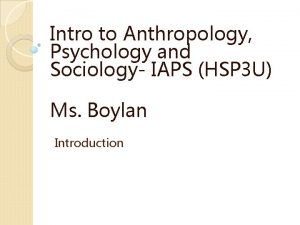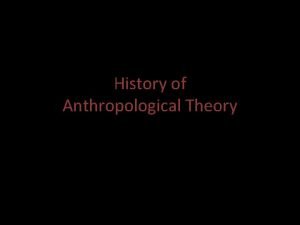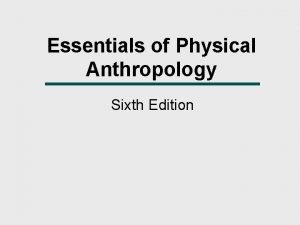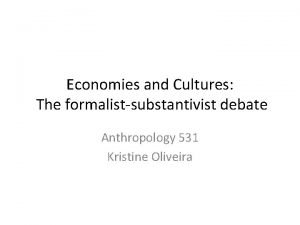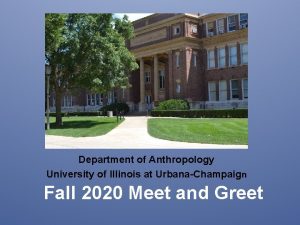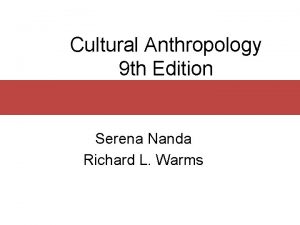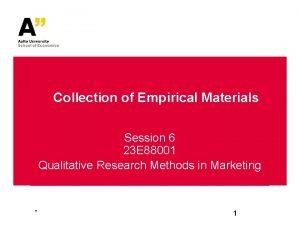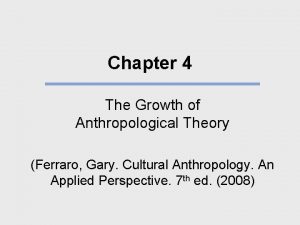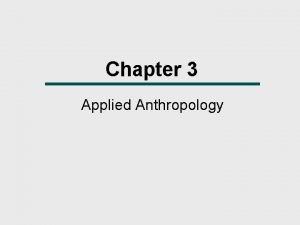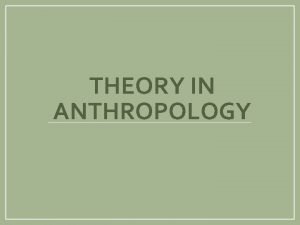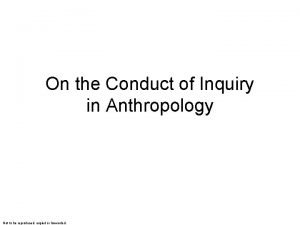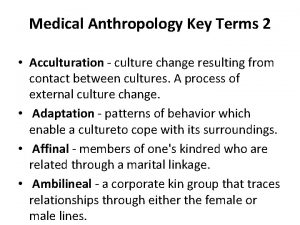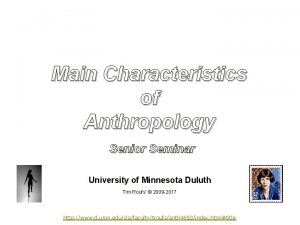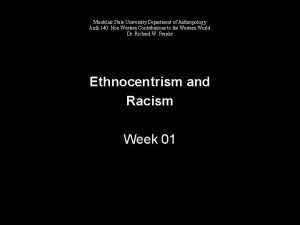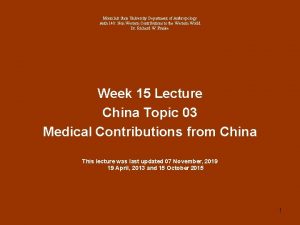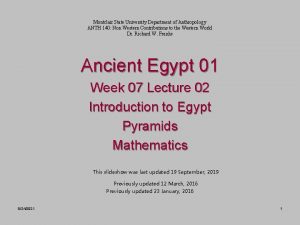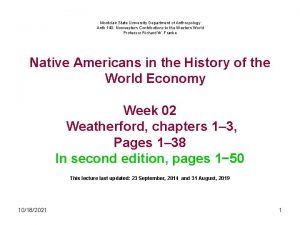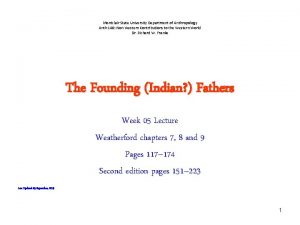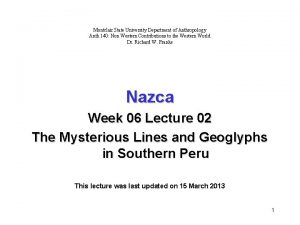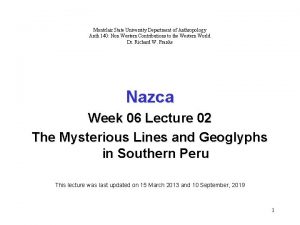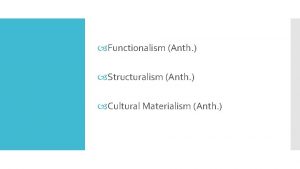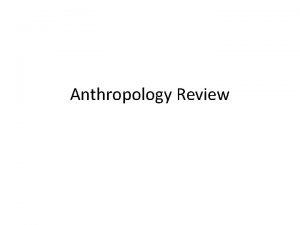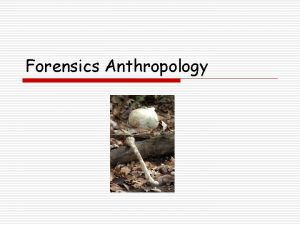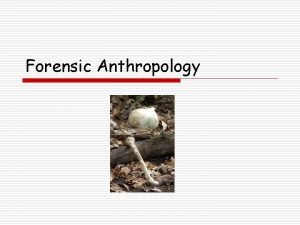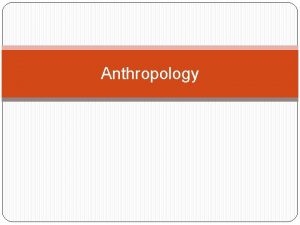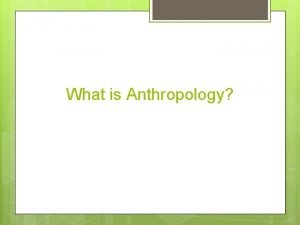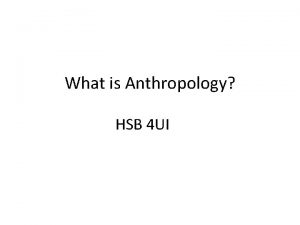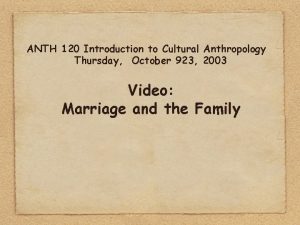Montclair State University Department of Anthropology Anth 140




























































- Slides: 60

Montclair State University Department of Anthropology Anth 140: Non Western Contributions to the Western World Dr. Richard W. Franke The Non Western History of Writing and the Alphabet Week 07 Lecture 01 This lecture was last updated 16 September, 2019 Previously updated on 12 March, 2016 Previously updated 22 March, 2013 3/12/2016 1

Montclair State University Department of Anthropology Anth 140: Non Western Contributions to the Western World Dr. Richard W. Franke The Origins of Writing and the Alphabet The learning objectives for week 07 lecture 01 are: – to appreciate the nonwestern origin of writing and the alphabet; – to understand the superiority of the alphabet as a means of writing; – to understand the continuing use of some prealphabetic writing systems such as hieroglyphs 3/12/2016 2

Montclair State University Department of Anthropology Anth 140: Non Western Contributions to the Western World Dr. Richard W. Franke The Origins of Writing and the Alphabet Week 07 lecture 01 terms you should know: – Hieroglyph – Cartouche – Rosetta Stone 3/12/2016 3

Montclair State University Department of Anthropology Anth 140: Non Western Contributions to the Western World: Dr. Richard W. Franke The Origins of Writing and the Alphabet Week 07 Lecture 01 Sources: Budge, E. A. Wallis. 1983 [orig. 1910]. Egyptian Language: Easy Lessons in Egyptian Hieroglyphics. New York: Dover Publications. Morrow, Susan Brind. 2015. The Dawning Moon of the Mind: Unlocking the Pyramid Texts. New York: Farrar, Strauss and Giroux. Parkinson, Richard, and Stephen Quirke. 1995. Papyrus. Austin: University of Texas Press. Robinson, Andrew. 1995. The Story of Writing: Alphabets, Hieroglyphs and Pictograms. London: Thames and Hudson. Zauzich, Karl-Theodor. 1992. Hieroglyphs without Mystery: An Introduction to Ancient Egyptian Writing. Translated and Adapted for English-Speaking Readers by Ann Macy Roth. Austin: University of Texas Press. 3/12/2016 4

Montclair State University Department of Anthropology Anth 140: Non Western Contributions to the Western World Dr. Richard W. Franke Writing and the Alphabet 1. Writing one of the most significant inventions of all time • • • 3/12/2016 Allows storage of knowledge Allows accumulation of knowledge Allows much greater and faster communication and sharing of ideas 5

Montclair State University Department of Anthropology Anth 140: Non Western Contributions to the Western World Dr. Richard W. Franke Writing and the Alphabet 2. Many pictorial writing systems in use worldwide – eg Native American drawing to be shown on slide 15 3/12/2016 6

Montclair State University Department of Anthropology Anth 140: Non Western Contributions to the Western World Dr. Richard W. Franke Writing and the Alphabet 3. True writing developed at least three times – Ancient Middle East – Sumer and Egypt – around 4, 000 BC – Ancient China – about the same time – Maya of Central America – around 2, 000 BC 3/12/2016 7

Montclair State University Department of Anthropology Anth 140: Non Western Contributions to the Western World Dr. Richard W. Franke 3/12/2016 8

Montclair State University Department of Anthropology Anth 140: Non Western Contributions to the Western World Dr. Richard W. Franke Writing and the Alphabet 4. True writing is writing that can convey everything humans are capable of thinking – Picture writing is limited in its ability to achieve this – True writing developed into the alphabet 3/12/2016 9

Montclair State University Department of Anthropology Anth 140: Non Western Contributions to the Western World Dr. Richard W. Franke Writing and the Alphabet 5. Alphabet the most efficient system of writing – Letters represent only the sounds – Meaning comes only from the sounds – A few letters can be endlessly recycled (called “duality of patterning” in linguistics) – Much easier to learn 3/12/2016 10

Montclair State University Department of Anthropology Anth 140: Non Western Contributions to the Western World Dr. Richard W. Franke Writing and the Alphabet 6. True alphabet maybe invented only once – Derived from Egyptian hieroglyphs – Developed over the millenium 3000 BC to 2000 BC in Egypt – “North Semitic” people took to ancient Canaan – Phoenicians took to Greeks 3/12/2016 11

Montclair State University Department of Anthropology Anth 140: Non Western Contributions to the Western World Dr. Richard W. Franke Writing and the Alphabet – Greeks added vowel sounds – Our word “alphabet” is the first two letters of the Greek alphabet – Alpha and beta come from Semitic “aleph” and “beth, ” still seen in Hebrew alphabet – Aleph originally picture of ox head – Can trace back to 4000 BC to Sumerian “gub” 3/12/2016 12

Montclair State University Department of Anthropology Anth 140: Non Western Contributions to the Western World Dr. Richard W. Franke Writing and the Alphabet Can you go from the Semitic on to the Greek and then Roman letters? 3/12/2016 13

Montclair State University Department of Anthropology Anth 140: Non Western Contributions to the Western World Dr. Richard W. Franke Writing and the Alphabet. Steps in writing and the alphabet – First came picture writing – See the Native American picture writing example on the next page 3/12/2016 14

Montclair State University Department of Anthropology Anth 140: Non Western Contributions to the Western World Dr. Richard W. Franke Writing and the Alphabet 3/12/2016 15

Montclair State University Department of Anthropology Anth 140: Non Western Contributions to the Western World Dr. Richard W. Franke Writing and the Alphabet 8. Next came “logogramic” writing – Mixture of pictures and sound elements – Chinese character writing is an example 3/12/2016 16

Montclair State University Department of Anthropology Anth 140: Non Western Contributions to the Western World Dr. Richard W. Franke Writing and the Alphabet 3/12/2016 17

Montclair State University Department of Anthropology Anth 140: Non Western Contributions to the Western World Dr. Richard W. Franke Writing and the Alphabet 8. The modern Western – or Roman – alphabet derives ultimately from a process similar to that of Chinese, except that the Egyptians gradually transformed their hieroglyphics (“sacred pictures”) into more abstract – sound related or “phonetic” – symbols → 3/12/2016 18

Montclair State University Department of Anthropology Anth 140: Non Western Contributions to the Western World Dr. Richard W. Franke Writing and the Alphabet 3/12/2016 19

Montclair State University Department of Anthropology Anth 140: Non Western Contributions to the Western World Dr. Richard W. Franke Writing and the Alphabet 9. The gift of alphabetic writing comes to us from three main sources: – Ancient Sumer (Babylonia) around 4, 000 BC – Ancient Egypt 3000 BC to 2000 BC – The ancient semitic peoples (later some came to call themselves Jews, possibly from “people of Judah”) 3/12/2016 20

Montclair State University Department of Anthropology Anth 140: Non Western Contributions to the Western World Dr. Richard W. Franke Writing and the Alphabet 10. Of these, the most important were the Egyptians – Developed the earliest writing of the Sumerians – Transformed hieroglyphs into near alphabetic or true alphabetic writing – Passed on their system to the nearby North Semitic cultures 3/12/2016 21

Montclair State University Department of Anthropology Anth 140: Non Western Contributions to the Western World Dr. Richard W. Franke Writing and the Alphabet 11. The earliest hierglyph s (3000 BC) were pictures 3/12/2016 22

Montclair State University Department of Anthropology Anth 140: Non Western Contributions to the Western World Dr. Richard W. Franke Writing and the Alphabet 12. Hieroglyphs are still in use 3/12/2016 23

Montclair State University Department of Anthropology Anth 140: Non Western Contributions to the Western World Dr. Richard W. Franke 2013 Update Writing and the Alphabet 12 a. Hieroglyphs are still in use – do they make use of the phone faster? 3/12/2016 24

Montclair State University Department of Anthropology Anth 140: Non Western Contributions to the Western World Dr. Richard W. Franke Writing and the Alphabet 13. Egyptian writing disappeared around 500 AD. 14. By 1700 no one had any idea what the strange picture-like drawings meant 15. Then, in 1799 a French military officer in Egypt made an astonishing discovery 3/12/2016 25

Montclair State University Department of Anthropology Anth 140: Non Western Contributions to the Western World Dr. Richard W. Franke Writing and the Alphabet 16. He picked up a stone in the village of el Rashid – now known in English as “Rosetta. ” 17. He saw strange writing on the stone and passed it on to his superiors who immediately realized it was a document of great historical importance. 3/12/2016 26

Montclair State University Department of Anthropology Anth 140: Non Western Contributions to the Western World Dr. Richard W. Franke Writing and the Alphabet 18. The Rosetta Stone provided the key to unlocking the ancient Egyptian hieroglyphs 3/12/2016 27

Montclair State University Department of Anthropology Anth 140: Non Western Contributions to the Western World Dr. Richard W. Franke Writing and the Alphabet 19. The Rosetta Stone had been carved in 196 BC 20. It contained an inscription by priests honoring then Egyptian pharaoh 3/12/2016 28

Montclair State University Department of Anthropology Anth 140: Non Western Contributions to the Western World Dr. Richard W. Franke Writing and the Alphabet 21. The inscription was written in three languages – Ancient hieroglyphs – Demotic, a writing system for Egyptian commoners – Greek, which was the language of the Egyptian rulers in 196 BC 3/12/2016 29

Montclair State University Department of Anthropology Anth 140: Non Western Contributions to the Western World Dr. Richard W. Franke The Rosetta Stone 3/12/2016 30

Montclair State University Department of Anthropology Anth 140: Non Western Contributions to the Western World Dr. Richard W. Franke Writing and the Alphabet 22. The Rosetta Stone was deciphered in 1822 by the French scholar Jean. François Champillion. 23. Champillion knew Greek and also Coptic – the language of Ethiopian Christianity that is derived from ancient Egyptian 3/12/2016 31

Montclair State University Department of Anthropology Anth 140: Non Western Contributions to the Western World Dr. Richard W. Franke Writing and the Alphabet 24. Through his knowledge of those two ancient languages and with much hard work he was able to decipher the first seven signs from demotic to Coptic 25…and from there he gradually worked out the meaning of the other symbols 3/12/2016 32

Montclair State University Department of Anthropology Anth 140: Non Western Contributions to the Western World Dr. Richard W. Franke 26. Egyptian Writing Principle No. 1 3/12/2016 33

Montclair State University Department of Anthropology Anth 140: Non Western Contributions to the Western World Dr. Richard W. Franke Egyptian Writing 27. Egyptian writing principle no. 2 – Only consonents have writen symbols – Vowels are figured out – – 3 rd flr apt in hse, 4 lg rms, exclnt loc nr cntr, nr rr, prkg, w-b-frpl, hdwd flrs, skylts, ldry, $600 lincl ht. 3/12/2016 34

Montclair State University Department of Anthropology Anth 140: Non Western Contributions to the Western World Dr. Richard W. Franke Egyptian Writing 28. Consonants-only writing is still common in modern Arabic and Hebrew 3/12/2016 35

Montclair State University Department of Anthropology Anth 140: Non Western Contributions to the Western World Dr. Richard W. Franke Egyptian Writing 29. Principle #3 is the “determinative, ” marking a sound to make it into a picture meaning: The “mouth” symbol denotes the sound “r” The determinative stroke causes it to mean “mouth” or “speech” 3/12/2016 36

Montclair State University Department of Anthropology Anth 140: Non Western Contributions to the Western World Dr. Richard W. Franke Egyptian Writing 30. Advanced writing techniques nb = all, any, every nfr = beautiful 3/12/2016 37

Montclair State University Department of Anthropology Anth 140: Non Western Contributions to the Western World Dr. Richard W. Franke Egyptian Writing 31. More advanced techniques sba = star pr = go forth running legs indicate verb of motion 3/12/2016 38

Montclair State University Department of Anthropology Anth 140: Non Western Contributions to the Western World Dr. Richard W. Franke Egyptian Writing 32. The Egyptian scribes’ attachment to aesthetics led them from the balanced rectangle to the rounded off rectangle we know as a “cartouche” 3/12/2016 39

Montclair State University Department of Anthropology Anth 140: Non Western Contributions to the Western World Dr. Richard W. Franke 33. Cartouches were especially popular as emblems for the pharaohs – This one is perhaps the most famous of them all… 3/12/2016 40

Montclair State University Department of Anthropology Anth 140: Non Western Contributions to the Western World Dr. Richard W. Franke Egyptian Writing 34. The boy-king – Tutankhamun, Ruler of Thebes (Ruled 1333 to 1324 BC) 3/12/2016 41

Montclair State University Department of Anthropology Anth 140: Non Western Contributions to the Western World Dr. Richard W. Franke Egyptian Writing 35. Red arrows show order of spelling of Tutankhamun – do you recognize the “ankh” part of his name? Blue lines show “ruler of Thebes of Upper Egypt” 3/12/2016 42

Montclair State University Department of Anthropology Anth 140: Non Western Contributions to the Western World Dr. Richard W. Franke Egyptian Writing 36. Here is the cartouche of another famous pharaoh – Ramses II who reigned for 66 years (1279 to 1213 BC) 3/12/2016 43

Montclair State University Department of Anthropology Anth 140: Non Western Contributions to the Western World Dr. Richard W. Franke Egyptian Writing 37. Some people believe Ramses is the pharaoh described in the Bible in Exodus – but there is no verification from the Egyptian materials 3/12/2016 44

Montclair State University Department of Anthropology Anth 140: Non Western Contributions to the Western World Dr. Richard W. Franke Writing and the Alphabet 38. We can only say for sure that by the time of Ramses II Egyptian writing had long been alphabetic and had influenced the spread of the alphabet to ancient Canaan and was probably on its way to the Greek islands. 3/12/2016 45

Montclair State University Department of Anthropology Anth 140: Non Western Contributions to the Western World Dr. Richard W. Franke Writing and the Alphabet: 2012 Update 39. Along with priestly hieroglyphics, Egyptian commoners had also developed a writing system, called “demotic, ” which is one of the three languages on the Rosetta Stone. 3/12/2016 46

Montclair State University Department of Anthropology Anth 140: Non Western Contributions to the Western World Dr. Richard W. Franke Writing and the Alphabet: 2012 Update 40. In 2012 scholars at the University of Chicago have published an online dictionary of 2, 000 words in Egyptian Demotic – words of family, love, words used in private letters. https: //www. nytimes. com/2012/09/18/science/new-demotic-dictionary-translates-lives-ofancient-egyptians. html? _r=1&ref=science&gwh=30 A 6 E 687832 BD 8 B 9 EB 7873 BF 1 D 5 CB 169 3/12/2016 47

Montclair State University Department of Anthropology Anth 140: Non Western Contributions to the Western World Dr. Richard W. Franke Writing and the Alphabet: 2012 Update 41. You can read the September 18, 2012 New York Times Science Section article about this dictionary here. You can directly access the dictionary at the University of Chicago Oriental Institute here. 3/12/2016 48

Montclair State University Department of Anthropology Anth 140: Non Western Contributions to the Western World Dr. Richard W. Franke Writing and the Alphabet: 2016 Update 42. Egyptian writing is known to be connected with religion, mysticism, poetry and multiple layers of imagery… 3/12/2016 This slide was added 12 March, 2016 49

Montclair State University Department of Anthropology Anth 140: Non Western Contributions to the Western World Dr. Richard W. Franke Writing and the Alphabet: 2016 Update 43. Archaeologist and Egyptologist Susan Brind Morrow has recently RE-translated some of the oldest and most mysterious of all the hieroglyphs… 3/12/2016 This slide was added 12 March, 2016 50

Montclair State University Department of Anthropology Anth 140: Non Western Contributions to the Western World Dr. Richard W. Franke Writing and the Alphabet: 2016 Update 44. Known as the “pyramid texts, ” these writings are found all over the inside walls of 5 th Dynasty pharaohs’ tombs at a site called Saqqara near modern Cairo. 3/12/2016 This slide was added 12 March, 2016 51

Montclair State University Department of Anthropology Anth 140: Non Western Contributions to the Western World Dr. Richard W. Franke Writing and the Alphabet: 2016 Update 45. By contrast, the more famous and older 4 th Dynasty pyramids of 2, 613 BCE (Before the Common Era = BC in the older notation) to 2, 495 BCE – see the next lecture – while mathematically amazing – contain no writing at all. 3/12/2016 This slide was added 12 March, 2016 52

Montclair State University Department of Anthropology Anth 140: Non Western Contributions to the Western World Dr. Richard W. Franke Writing and the Alphabet: 2016 Update 46. The 5 th Dynasty runs from about 2, 494 BCE to 2, 345 – the approximate date of the burial of the Pharaoh Unis (or Unas). 3/12/2016 This slide was added 12 March, 2016 53

Montclair State University Department of Anthropology Anth 140: Non Western Contributions to the Western World Dr. Richard W. Franke Writing and the Alphabet: 2016 Update 47. On the inside West wall of Unis’s pyramid, one sees… [written in about 2, 345 BCE = about one thousand years before Moses wrote down the book of Genesis] 3/12/2016 This slide was added 12 March, 2016 54

Montclair State University Department of Anthropology Anth 140: Non Western Contributions to the Western World Dr. Richard W. Franke Source: Morrow, Susan Brind. 2015. The Dawning Moon of the Mind: Unlocking the Pyramid Texts. New York: Farrar, Strauss and Giroux. Pages 20 – 21. 48. … “the earliest surviving body of written poetry and religious philosophy in the world. ” 3/12/2016 This slide was added 12 March, 2016 55

Montclair State University Department of Anthropology Anth 140: Non Western Contributions to the Western World Dr. Richard W. Franke Writing and the Alphabet: 2016 Update 49. Partial translation of this text from about 2, 345 BCE: Over the fire Beneath the holy ones as they grow dark As the falcon flies, as the falcon flies May Unis rise into this fire Beneath the holy ones as they grow dark They make a path for Unis takes the path 3/12/2016 This slide was added 12 March, 2016 56

Montclair State University Department of Anthropology Anth 140: Non Western Contributions to the Western World Dr. Richard W. Franke Writing and the Alphabet: 2016 Update 50. Growing dark may refer to the dawn when the stars (which the Egyptians thought were gods in the sky) grow dark and the falcon grabs the deceased’s soul to carry him towards the sky…. 3/12/2016 This slide was added 12 March, 2016 57

Montclair State University Department of Anthropology Anth 140: Non Western Contributions to the Western World Dr. Richard W. Franke Writing and the Alphabet: 2016 Update 50. …and much more is hidden in several multiple meanings that only emerge when one has studied the hieroglyphs themselves… 3/12/2016 This slide was added 12 March, 2016 58

Montclair State University Department of Anthropology Anth 140: Non Western Contributions to the Western World Dr. Richard W. Franke Writing and the Alphabet: 2016 Update 51. If you are interested in the multiple images and complex meanings of this and other pyramid texts, see her fascinating book. 3/12/2016 This slide was added 12 March, 2016 59

Montclair State University Department of Anthropology Anth 140: Non Western Contributions to the Western World Dr. Richard W. Franke Writing and the Alphabet End of Week 07 Lecture 01 Writing and the Alphabet 3/12/2016 60
 Anthropology montclair nj
Anthropology montclair nj Montclair state university internships
Montclair state university internships Erik jacobson montclair state university
Erik jacobson montclair state university Montclair health department
Montclair health department Anth 1210
Anth 1210 Cultural anthropology definition
Cultural anthropology definition Anth 331
Anth 331 Department of anthropology
Department of anthropology Psychology texas state
Psychology texas state Jackson state university finance department
Jackson state university finance department Michigan state physics
Michigan state physics Mobile phones in montclair
Mobile phones in montclair Msu click irb
Msu click irb Department of law university of jammu
Department of law university of jammu Department of geology university of dhaka
Department of geology university of dhaka University of padova psychology
University of padova psychology University of bridgeport it department
University of bridgeport it department University of iowa math department
University of iowa math department Sputonik
Sputonik Department of information engineering university of padova
Department of information engineering university of padova Department of information engineering university of padova
Department of information engineering university of padova Manipal university chemistry department
Manipal university chemistry department Syracuse university pool
Syracuse university pool Mice.cs.columbia
Mice.cs.columbia Columbia university cs department
Columbia university cs department University of sargodha engineering department
University of sargodha engineering department Claudia arrighi
Claudia arrighi Washington state department of social and health services
Washington state department of social and health services Nevada department of business and industry
Nevada department of business and industry Nevada department of business and industry
Nevada department of business and industry State of florida department of juvenile justice
State of florida department of juvenile justice State of alabama department of finance
State of alabama department of finance Nysdot hdm
Nysdot hdm The state department us for
The state department us for Oklahoma state standards
Oklahoma state standards Penn state meteorology
Penn state meteorology State of nevada department of business and industry
State of nevada department of business and industry Lumpers and splitters anthropology
Lumpers and splitters anthropology Thick description anthropology
Thick description anthropology Example of perspective anthropology
Example of perspective anthropology Perspective of anthropology and examples
Perspective of anthropology and examples Body language
Body language Phonemes anthropology
Phonemes anthropology What is anthropology
What is anthropology Introduction to anthropology psychology and sociology
Introduction to anthropology psychology and sociology Who founded anthropology
Who founded anthropology Blowfly life cycle
Blowfly life cycle Physical anthropology subfields
Physical anthropology subfields Formalist substantivist debate
Formalist substantivist debate Krystiana krupa
Krystiana krupa Example of anthropology
Example of anthropology Discussion guide template
Discussion guide template Psychological anthropology
Psychological anthropology Types of anthropology
Types of anthropology Biological anthropology
Biological anthropology Anthropology sociology psychology venn diagram
Anthropology sociology psychology venn diagram Rapid change
Rapid change Configurationalism definition
Configurationalism definition Verandah anthropology
Verandah anthropology Acculturation anthropology
Acculturation anthropology Characteristic of culture
Characteristic of culture




